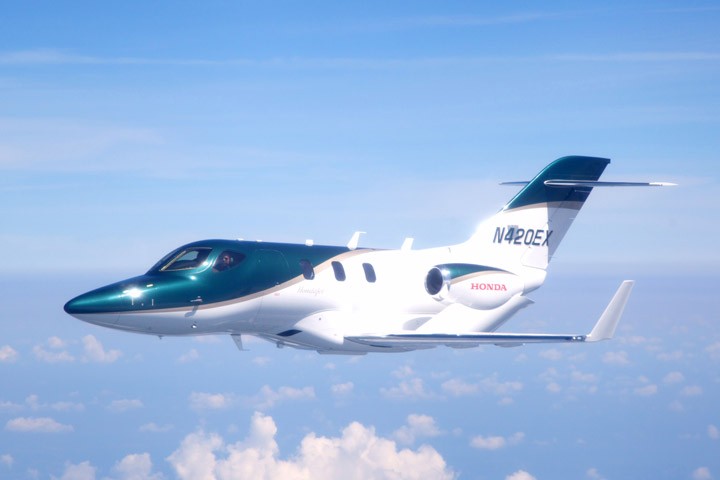As the world awaits the return of the Acura NSX (whenever that might be), Honda has just launched its fastest and most expensive vehicle ever. After almost seven years of development, the first production version of the HondaJet took to the skies over North Carolina last week.
The milestone test flight lasted 84 minutes, and the HondaJet was able to fly at 348 knots (400 mph) at an altitude of 15,500 feet, which aren’t even close to pushing the limits of its max cruising numbers of 420 knots (483 mph) or its max altitude of 43,000 feet. As expected, the shake-down flight was used to test certain functins of the aircraft including handling, avionics and mechanical operations like the landing gears and flaps.
The HondaJet took off from and landed at the Honda Aircraft Company headquarters located at the Piedmont Triad International Airport in Greensboro, NC. When the green, gold and white HondaJet returned to the ground, the plane and crew were greeted by a crowd of 1,000 HondaJet team members who were on hand to celebrate the maiden flight.
This test flight marked a significant step in being certified for flight by the Federal Aviation Administration (FAA), and the plane is expected to enter into service next year for customers in North America and Europe. Honda plans to have aircraft available for immediate delivery after the FAA certification is announced. Of the momentous first flight, Honda Aircraft Company president and CEO Michimasa Fujino said:
"With this first flight, the HondaJet program has entered the next exciting phase as we prepare for delivery. Today's celebration is the culmination of extensive engineering and production efforts, and this is an important achievement in bringing the world's most advanced light jet to market."
The five-passenger HondaJet can travel up to 1,180 nautical miles (1,357 miles) meaning that it can fly non-stop from New York to Miami. More importantly, it can take off from runways less than 4,000, and land on runways that are less than 3,000 feet.
The HondaJet took off from and landed at the Honda Aircraft Company headquarters located at the Piedmont Triad International Airport in Greensboro, NC. When the green, gold and white HondaJet returned to the ground, the plane and crew were greeted by a crowd of 1,000 HondaJet team members who were on hand to celebrate the maiden flight.
This test flight marked a significant step in being certified for flight by the Federal Aviation Administration (FAA), and the plane is expected to enter into service next year for customers in North America and Europe. Honda plans to have aircraft available for immediate delivery after the FAA certification is announced. Of the momentous first flight, Honda Aircraft Company president and CEO Michimasa Fujino said:
"With this first flight, the HondaJet program has entered the next exciting phase as we prepare for delivery. Today's celebration is the culmination of extensive engineering and production efforts, and this is an important achievement in bringing the world's most advanced light jet to market."
The five-passenger HondaJet can travel up to 1,180 nautical miles (1,357 miles) meaning that it can fly non-stop from New York to Miami. More importantly, it can take off from runways less than 4,000, and land on runways that are less than 3,000 feet.


